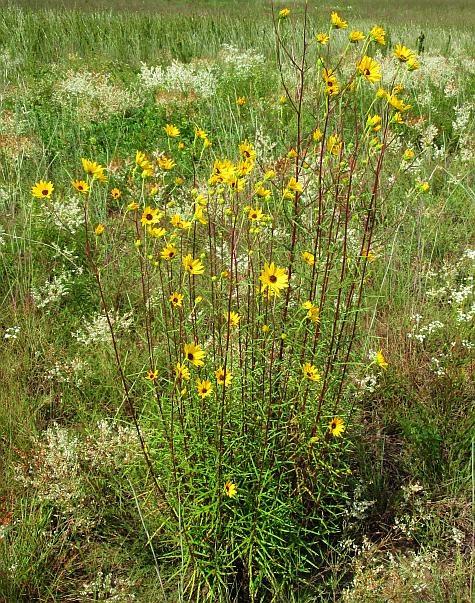Helianthus angustifolius L.
Narrow-Leaved Sunflower

Native
CC = 8
CW = -3
MOC = 5
SRank = S2
© DETenaglia
Helianthus angustifolius L.Narrow-Leaved Sunflower | |
 |
Native CC = 8 CW = -3 MOC = 5 SRank = S2 |
© DETenaglia |
|
Family - Asteraceae/Heliantheae Habit - Perennial forb with a short, clumped rootstock, with rhizomes absent or very short, not occurring as colonies of stems. Stem - Loosely ascending to erect, to 1.7 m, usually solitary, unbranched below the inflorescence, moderately pubescent with slender, mostly loosely ascending, minutely pustular-based hairs, these often sparser above the stem midpoint.
Leaves - Mostly alternate, simple, sessile or nearly so, relatively numerous and well developed along the stem (usually more than 30 nodes). Blades of the stem leaves 3-20 cm long, 0.1-1.0 cm wide, linear or those of the lowermost leaves sometimes narrowly lanceolate (mostly 7-20 times as long as wide), not folded longitudinally, mostly short-tapered at the base, tapered to a sharply pointed tip, the margins entire, mostly curled under, the upper surface moderately roughened with stiff, pustular-based hairs (these often shed, leaving only the expanded base), the undersurface usually pale green, moderately to densely pubescent with somewhat tangled, soft, easily shed hairs, both surfaces often also with scattered, sessile, yellow glands, with 1 main vein. Petiolate basal leaves to 2 cm wide sometimes present.
Inflorescences - Solitary terminal heads, or open, few-headed clusters of heads, the heads mostly long-stalked.
Heads - Radiate. Involucre 8-12 mm long, 12-20 mm in diameter, extending to about the tips of the disc corollas. Bracts in 2 or 3 subequal series, lanceolate to narrowly lanceolate, tapered to a sharply pointed, slender, loosely ascending to recurved tip, the margins and outer surface sparsely to moderately roughened with minute, ascending, pustular-based hairs and also with sessile, yellow glands. Receptacle shallowly convex, the chaffy bracts 5.5-6.5 mm long, oblong-oblanceolate, tapered to a sharply pointed, purplish-tinged, glabrous tip, the outer surface minutely hairy.
Florets - Ray florets 10-21, sterile, the corolla 1.2-3.0 cm long, yellow, minutely hairy and with sessile, yellow glands on the outer surface. Disc florets perfect, the corollas 4.0-4.5 mm long, the lobes and tip of the tube reddish brown to dark purple above a sometimes yellowish basal portion. Pappus of 2 scales 1.5-2.0 mm long, these lanceolate, tapered to a sharply pointed, minute, awnlike tip, occasionally with an additional pair of thin, irregular apical lobes.
Fruits - Achenes 2-3 mm long, more or less wedge-shaped, flattened but 4-angled in cross-section, the surface glabrous, finely mottled with dark brown to nearly black and lighter brown patches.
Flowering - August - October. Habitat - Upland prairies, sand prairies, savannas, pastures, ditches, and roadsides. Also cultivated. Origin - Native to the U.S. Lookalikes - H. salicifolius; broadly, other species of Helianthus and numerous other plants in the aster family. Other info. - This attractive species is uncommon in Missouri, mostly restricted to the sand prairies of the Mississippi Lowlands region. Missouri is at the northwestern edge of the plant's natural range, which extends throughout much of the Southeast. The plant is easily recognized by its habitat, sunflower heads, and very narrow leaves. These features are also present on the lookalike H. salicifolius, but that plant has glabrous and often glaucous stems, and is also more strongly colonial. Photographs taken at Sand Prairie Conservation Area, Scott County, MO, 9-8-2019 (KBildner); also about 4.5 miles southeast of Benton, Scott County, MO, 10-5-2017, and at Sand Prairie Conservation Area, Scott County, MO, 9-7-2020 (SRTurner). |